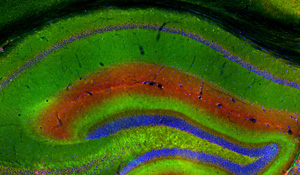Jun. 5, 2015 Research Highlight Biology
The chemical attraction underlying synaptic diversity
Cell adhesion molecules regulate the formation and function of specialized structures involved in neuron-to-neuron communication in the brain
 Figure 1: A cell adhesion molecule called netrin-G regulates the formation and function of specialized structures involved in inter-neuron communication in the brain. Modified, with permission, from Ref. 1 © 2015 H. Matsukawa et al.
Figure 1: A cell adhesion molecule called netrin-G regulates the formation and function of specialized structures involved in inter-neuron communication in the brain. Modified, with permission, from Ref. 1 © 2015 H. Matsukawa et al.
A type of cell adhesion molecule called netrin-G tethers discrete synaptic circuits together in the brain to regulate neural circuit function, finds an international team of researchers led by Shigeyoshi Itohara from the RIKEN Brain Science Institute1. This finding offers new insight into how diversity is created in neural circuits with potential relevance to neurological disorders such as schizophrenia.
The transmission of information in the brain relies on the precise arrangement of connections between neurons. The formation of these connections, called synapses, is controlled by cell adhesion molecules expressed on the neuron surface. Netrin-G1 and netrin-G2 are two such molecules, which bind to their specific binding partners, netrin-G1 ligand (NGL1) and netrin-G2 ligand (NGL2).
The researchers used immunoelectron microscopy techniques to observe synapses in the hippocampus, where netrin-G1 and netrin-G2 had previously been found in distinct neuronal populations. This investigation revealed that netrin-G proteins occur on the presynaptic membrane, while NGLs occur on the postsynaptic membrane. Studying mice missing just one of these molecules, Itohara’s team discovered that mice lacking either of the receptors had reduced levels of netrin-G at the synapse, suggesting that netrin-Gs and NGLs were mutually required to keep the respective molecules at the synapses.
The loss of netrin-G or NGL led to changes in synaptic functions in a circuit-specific manner. For example, the strengthening of a certain neuronal circuit by the application of a long train of stimulatory pulses—a type of synaptic plasticity thought to play a role in learning—was suppressed in mice deficient in netrin-G1 or NGL1, but occurred normally in mice deficient in netrin-G2 or NGL2. Yet in another synaptic circuit, this synaptic ‘potentiation’ was enhanced in mice deficient in netrin-G2 or NGL2, but not in mice deficient in netrin-G1 or NGL1.
Overall, the results suggest that particular netrin-G–NGL pairings are required across the synapse to maintain normal synaptic function in a circuit-specific manner. In other words, the formation of synaptic structures and the diversity of their functions are mediated, at least in part, by the expression of various cell adhesion molecules and their receptors in different neurons within a particular brain structure and neural network.
“Human genetic studies have suggested the involvement of netrin-G1 and netrin-G2 in various neurological diseases, including schizophrenia and bipolar disorder,” explains Itohara. “The interactions between netrin-G and its receptors determine the circuit-specific characteristics of synapses and might even underlie the elaboration of higher brain function in humans,” he says.
References
- 1. Matsukawa, H., Akiyoshi-Nishimura, S., Zhang, Q., Luján, R., Yamaguchi, K., Goto, H., Yaguchi, K., Hashikawa, T., Sano, C., Shigemoto, R. et al. Netrin-G/NGL complexes encode functional synaptic diversification. The Journal of Neuroscience 34, 15779–15792 (2015). doi: 10.1523/JNEUROSCI.1141-14.2014
